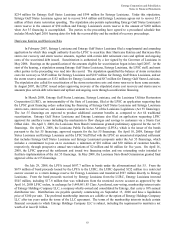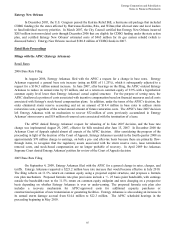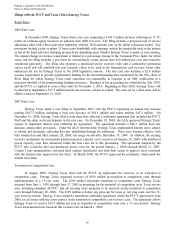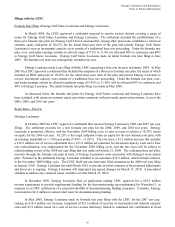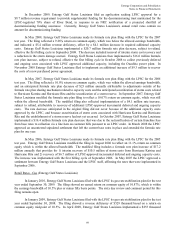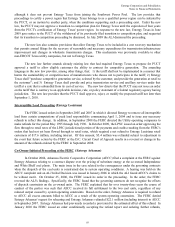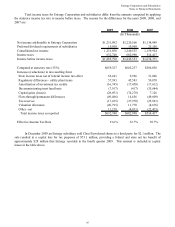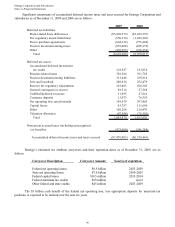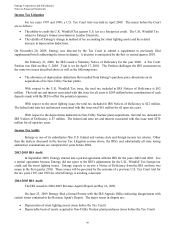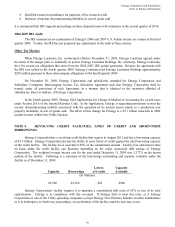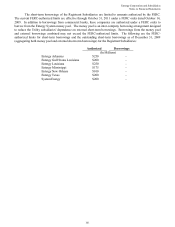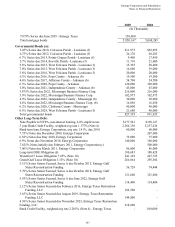Entergy 2009 Annual Report Download - page 95
Download and view the complete annual report
Please find page 95 of the 2009 Entergy annual report below. You can navigate through the pages in the report by either clicking on the pages listed below, or by using the keyword search tool below to find specific information within the annual report.
Entergy Corporation and Subsidiaries
Notes to Financial Statements
91
although it does not prevent Entergy Texas from joining the Southwest Power Pool. The law provides that
proceedings to certify a power region that Entergy Texas belongs to as a qualified power region can be initiated by
the PUCT, or on motion by another party, when the conditions supporting such a proceeding exist. Under the new
law, the PUCT may not approve a transition to competition plan for Entergy Texas until the expiration of four years
from the PUCT's certification of Entergy Texas' power region. In response to the new law, Entergy Texas in June
2009 gave notice to the PUCT of the withdrawal of its previously filed transition to competition plan, and requested
that its transition to competition proceeding be dismissed. In July 2009 the ALJ dismissed the proceeding.
The new law also contains provisions that allow Entergy Texas to be included in a cost recovery mechanism
that permits annual filings for the recovery of reasonable and necessary expenditures for transmission infrastructure
improvement and changes in wholesale transmission charges. This mechanism was previously available to other
non-ERCOT Texas utility companies, but not to Entergy Texas.
The new law further amends already existing law that had required Entergy Texas to propose for PUCT
approval a tariff to allow eligible customers the ability to contract for competitive generation. The amending
language in the new law provides, among other things, that: 1) the tariff shall not be implemented in a manner that
harms the sustainability or competitiveness of manufacturers who choose not to participate in the tariff; 2) Entergy
Texas shall "purchase competitive generation service, selected by the customer, and provide the generation at retail to
the customer"; and 3) Entergy Texas shall provide and price transmission service and ancillary services under that
tariff at a rate that is unbundled from its cost of service. The new law directs that the PUCT may not issue an order
on the tariff that is contrary to an applicable decision, rule, or policy statement of a federal regulatory agency having
jurisdiction. The new law provides that the PUCT shall approve, reject, or modify the proposed tariff not later than
September 1, 2010.
Interruptible Load Proceeding (Entergy Louisiana)
The FERC issued orders in September 2005 and 2007 in which it directed Entergy to remove all interruptible
load from certain computations of peak load responsibility commencing April 1, 2004 and to issue any necessary
refunds to reflect this change. In addition, in September 2008 the FERC directed the Utility operating companies to
make refunds for the period May 1995 through July 1996. In October 2009, the LPSC issued an order approving the
flow through to retail rates of the LPSC-jurisdictional portion of the payments and credits resulting from the FERC's
orders that had not yet been flowed through to retail rates, which required a net refund to Entergy Louisiana retail
customers of $17.6 million, including interest. Of this amount, $5.4 million was refunded subject to adjustment in
the event that future action by the FERC or the D.C. Circuit Court of Appeals results in a reversal or change in the
amount of the refunds ordered by the FERC in September 2008.
Co-Owner-Initiated Proceeding at the FERC (Entergy Arkansas)
In October 2004, Arkansas Electric Cooperative Corporation (AECC) filed a complaint at the FERC against
Entergy Arkansas relating to a contract dispute over the pricing of substitute energy at the co-owned Independence
and White Bluff coal plants. The main issue in the case related to the consequences under the governing contracts
when the dispatch of the coal units is constrained due to system operating conditions. A hearing was held on the
AECC complaint and an ALJ Initial Decision was issued in January 2006 in which the ALJ found AECC's claims to
be without merit. On October 25, 2006, the FERC issued its order in the proceeding. In the order, the FERC
reversed the ALJ's findings. Specifically, the FERC found that the governing contracts do not recognize the effects
of dispatch constraints on the co-owned units. The FERC explained that for over twenty-three years the course of
conduct of the parties was such that AECC received its full entitlement to the two coal units, regardless of any
reduced output caused by system operating constraints. Based on the order, Entergy Arkansas is required to refund
to AECC all excess amounts billed to AECC as a result of the system operating constraints. The FERC denied
Entergy Arkansas' request for rehearing and Entergy Arkansas refunded $22.1 million (including interest) to AECC
in September 2007. Entergy Arkansas had previously recorded a provision for the estimated effect of this refund. In
January 2010 the FERC issued an order conditionally accepting the refund report and ordering further refunds,
93


